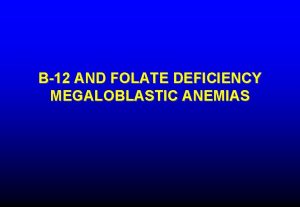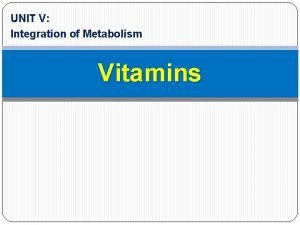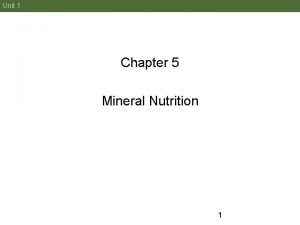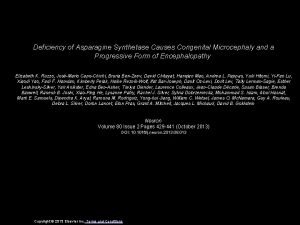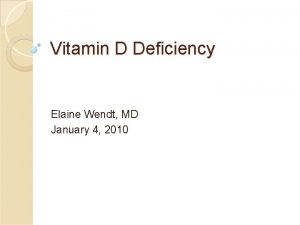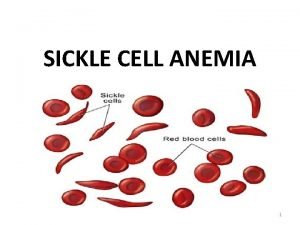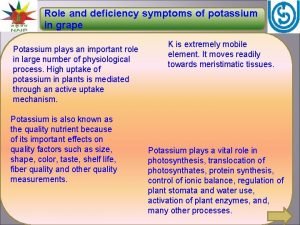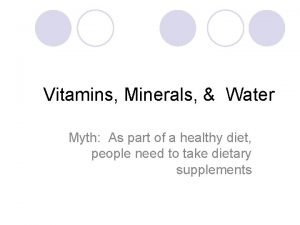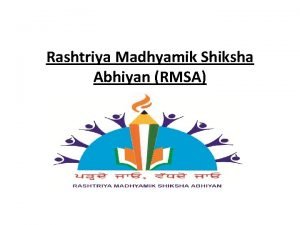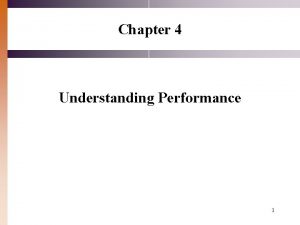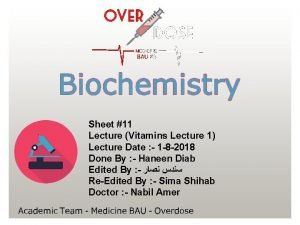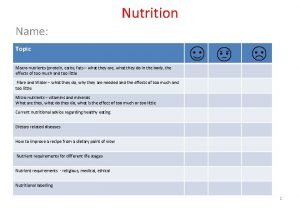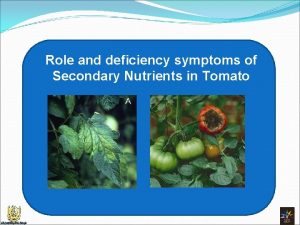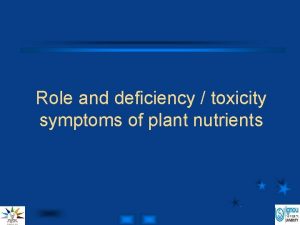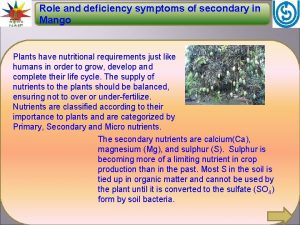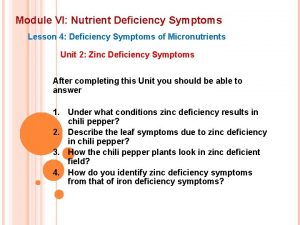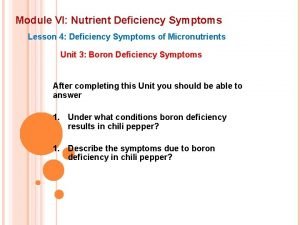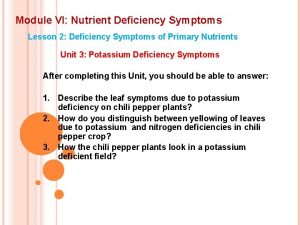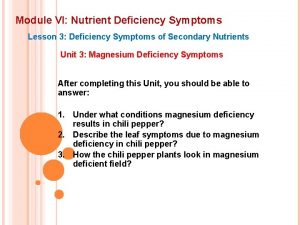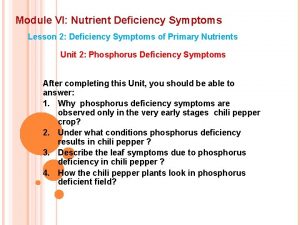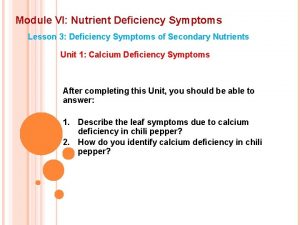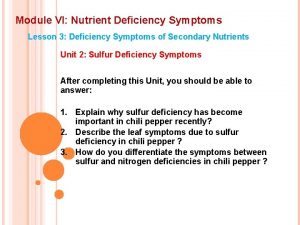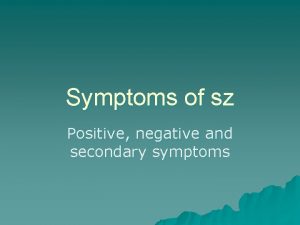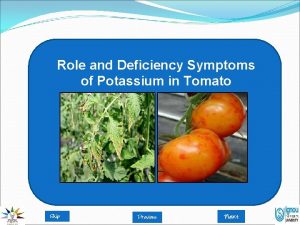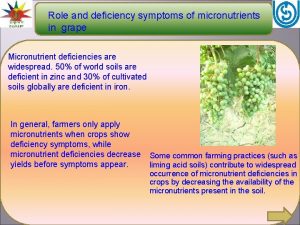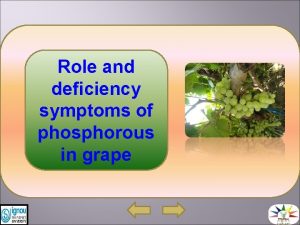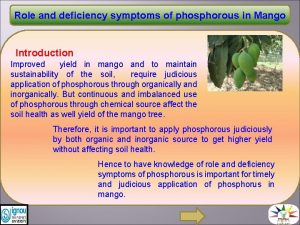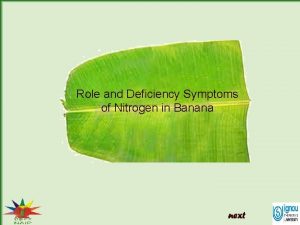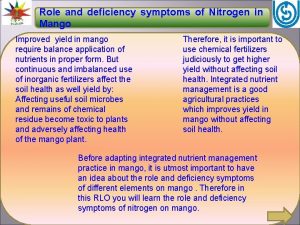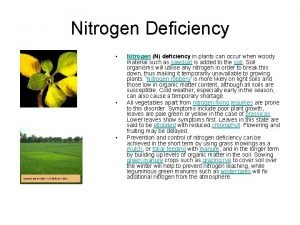Role and Deficiency Symptoms of Secondary Nutrients in























- Slides: 23

Role and Deficiency Symptoms of Secondary Nutrients in Rice

Role and Deficiency Symptoms of Secondary Nutrients in Rice Introduction In today’s agriculture with the emphasis on higher crop yields, there is an increased need for calcium, magnesium and sulphur, called secondary nutrients. Some of the factors responsible for this increased need are: Increased use of higher analysis fertilizers. Increased crop yields. High crop utilization of calcium, sulphur and magnesium.

Role and Deficiency Symptoms of Secondary Nutrients in Rice Introduction Decreased use of sulphur containing insecticides and fungicides Government restrictions on sulphur emissions to the atmosphere. Many soils are acidic and need limestone, which provides calcium. Many soils are deficient in sulphur and magnesium. Increased awareness of sulphur and magnesium needs.

Role and Deficiency Symptoms of Secondary Nutrients in Rice Sulphur (S): role in rice It is a constituent of essential amino acids (cysteine, methionine, and cystine) involved in chlorophyll production and is thus required for protein synthesis, and plant function and structure. Sulphur is also a constituent of coenzymes required in protein synthesis. It is contained in the plant hormones thiamine and biotine, both of which are involved in carbohydrate metabolism. S is also involved in some oxidation-reduction reactions. It is less mobile in the plant than N so that deficiency tends to appear first on young leaves. S deficiency affects human nutrition by causing a reduction in cysteine and methionine content in rice.

Role and Deficiency Symptoms of Secondary Nutrients in Rice Sulphur deficiency in rice: http: //www. flickr. com/photos/philrice/3176059128/

Role and Deficiency Symptoms of Secondary Nutrients in Rice Causes of S deficiency Low status of S in the soil. Depletion of soil S as a result of intensive cropping systems. Use of S-free fertilizers S concentrations in groundwater, however, may range widely. Irrigation water contains only small quantities of SO 42 -. S contained in organic residues is lost due to burning.

Role and Deficiency Symptoms of Secondary Nutrients in Rice Occurrence of S deficiency in soils Soils containing allophane (e. g. , Andisols) Soils with low organic matter status. Highly weathered soils containing large amounts of Fe oxides. Sandy soils, which are easily leached.

Role and Deficiency Symptoms of Secondary Nutrients in Rice Corrective measures of S deficiency is easily corrected or prevented by using S-containing fertilizers (Table 1) Table 1. Sulphur containing fertilizers for rice Name Ammonium sulphate Formula (NH 4)2 SO 4 Content 24% S Single superphosphate Ca(H 2 PO 4)2. H 2 O 12% S, 7– 9 % P, 13– + Ca. SO 4. 2 H 2 O 20% Ca Potassium sulphate K 2 SO 4 18% S Comments Quick-acting Soluble, quickacting Quick-acting Magnesium sulphate (Epsom salt) Kieserite Langbeinite Mg. SO 4. 7 H 20 13% S, 10% Mg Mg. SO 4. H 20 K 2 SO 4. Mg. SO 4 Very quickacting 23% S, 17% Mg Quick-acting 18% K, 11% Mg, 22% S Quick-acting Gypsum Elemental S S-coated urea Ca. SO 4 × 2 H 2 O S CO(NH 2)2 + S 17% S 97% S 6– 30% S, 30– 40% N Slow-acting

Role and Deficiency Symptoms of Secondary Nutrients in Rice Magnesium (Mg): role in rice Magnesium activates several enzymes. It is a constituent of chlorophyll, and is involved in CO 2 assimilation and protein synthesis. Mg also regulates cellular p. H and the cation-anion balance.

Role and Deficiency Symptoms of Secondary Nutrients in Rice Magnesium deficiency symptoms in rice It is very mobile and is retranslocated easily from old leaves to young leaves. Deficiency symptoms therefore tend to occur initially in older leaves. Mg-deficient plants are pale-coloured with interveinal chlorosis first appearing on older leaves, and later on younger leaves as deficiency becomes more severe. Green coloring appears as a "string of beads" compared with K deficiency, in which green and yellow stripes run parallel to the leaf.

Role and Deficiency Symptoms of Secondary Nutrients in Rice Magnesium deficiency symptoms in rice Leaf number and leaf length are greater in Mgdeficient plants and Mg-deficient leaves are wavy and droopy due to an expansion in the angle between the leaf sheath and leaf blade. With moderate deficiency, plant height and tiller number are not affected greatly. Reduced number of spikelets and reduced 1, 000 -grain weight. May reduce grain quality (% milled rice, protein, and starch content).

Role and Deficiency Symptoms of Secondary Nutrients in Rice Magnesium deficiency symptoms in rice Orange-yellow interveinal chlorosis usually appears first on older leaves Chlorosis may also appear on the flag leaf.

Role and Deficiency Symptoms of Secondary Nutrients in Rice Magnesium deficiency symptoms in rice Mg deficiency may also be induced by large applications of K fertilizer on low Mg status soils (IRRI, Phillipines)

Role and Deficiency Symptoms of Secondary Nutrients in Rice Causes and occurrence of Mg deficiency Important cause of Mg deficiency is low available soil Mg. Furthermore, decreased Mg uptake due to a wide ratio of exchangeable K: Mg (i. e. , >1: 1) causes its deficiency. Mg deficiency is more common in rainfed lowland upland rice where soil Mg has been depleted because of the continuous removal of Mg in crop products without recycling crop residues or replacing removed Mg with mineral fertilizer. Many rainfed rice soils are inherently deficient in Mg.

Role and Deficiency Symptoms of Secondary Nutrients in Rice Corrective measures of Mg deficiency Apply Mg-containing fertilizers (Table 2). Rapid correction of Mg deficiency symptoms is achieved by foliar application of liquid fertilizers containing Mg (e. g. , Mg. Cl 2). Table 2. Magnesium containing fertilizers for rice. Name Kieserite Formula Mg. SO 4. H 20 Content 17% Mg, 23% S Langbeinite K 2 SO 4, Mg. SO 4 Mg. Cl 2 18% K, 11% Mg, Quick-acting 22%S 9% Mg Soluble, quick-acting Mg. O 42% Mg Magnesium chloride Magnesium oxide Magnesite Dolomite Mg. CO 3. Ca. CO 3 Comments Soluble, quick-acting Slow-acting, for foliar application 25 -28% Mg Slow-acting 13% Mg, 21% Ca Slow-acting, content of Ca and Mg varying

Role and Deficiency Symptoms of Secondary Nutrients in Rice Calcium (Ca): role in rice Calcium is a constituent of Ca pectates, important cell wall constituents also involved in biomembrane maintenance. Helps in cell wall stabilization as an enzyme activator, in osmoregulation, and in the cationanion balance. Ca is less mobile in rice plants than Mg and K. Because Ca is not retranslocated to new growth, deficiency symptoms usually appear first on young leaves. Ca deficiency also results in impaired root function and may predispose the rice plant to Fe toxicity. An adequate supply of Ca increases resistance to diseases such as bacterial leaf blight or brown spot.

Role and Deficiency Symptoms of Secondary Nutrients in Rice Calcium deficiency symptoms in rice Symptoms are usually visible only under severe Ca deficiency (e. g. , pot experiments, exhaustion experiments). The tips of the youngest leaves become white or bleached, rolled, and curled. Necrotic tissue may develop along the lateral margins of leaves and old leaves eventually turn brown and die. Ca deficiency may resemble B deficiency and plant tissue analysis may be required to distinguish the cause of symptoms.

Role and Deficiency Symptoms of Secondary Nutrients in Rice Calcium deficiency symptoms in rice The tips of the youngest leaves may become chlorotic-white (IRRI, Phillipines)

Role and Deficiency Symptoms of Secondary Nutrients in Rice Causes of Ca deficiency Small amounts of available Ca in soil (degraded, acid, sandy soils) Alkaline p. H with a wide exchangeable Na: Ca ratio resulting in reduced Ca uptake. Use of irrigation water rich in Na. HCO 3. Excessive N or K fertilizer application resulting in wide NH 4: Ca or K: Ca ratios and reduced Ca uptake. Excessive P fertilizer application, which may depress the availability of Ca (due to formation of Ca phosphates in alkaline soils).

Role and Deficiency Symptoms of Secondary Nutrients in Rice Occurrence of Ca deficiency in soils Acid, strongly leached, low-CEC soils in uplands and lowlands Soils derived from serpentine rocks Coarse-textured sandy soils with high percolation rates and leaching Leached, old acid sulphate soils with low base content

Role and Deficiency Symptoms of Secondary Nutrients in Rice Corrective measures of Ca deficiency Apply Ca. Cl 2 (solid or in solution) or Cacontaining foliar sprays for quick treatment of severe Ca deficiency. Apply gypsum on Ca-deficient nonacidic soils, e. g. , on sodic and high-K soils. Apply lime on acid soils to raise p. H and Ca availability. Apply Mg or K in conjunction with Ca because Ca may cause deficiencies in these nutrients. Apply pyrites to mitigate the effects of Na. HCO 3 -rich water on Ca uptake.

Role and Deficiency Symptoms of Secondary Nutrients in Rice Corrective measures of Ca deficiency Table 3. Calcium containing fertilizer sources for rice. Name Formula Calcium chloride Ca. Cl 2 H 2 O Gypsum Ca. SO 4 H 2 O Dolomite Mg. CO 3 Ca. CO 3 Lime Ca. CO 3 . . Content 6 18% Ca 2 23% 18% S Comments Soluble, quick-acting, does not raise p. H Ca, Slightly soluble, slow-acting, for saline and alkaline soils + 13% Mg, Slow acting , content of Ca 21% Ca and Mg varying 40% Ca Slow-acting, for acid soils

Role and Deficiency Symptoms of Secondary Nutrients in Rice Let us sum up Calcium, magnesium and sulphur are essential for rice crop. Variety of roles are being played by these secondary nutrients in rice The deficiency of sulphur is more common than deficiency of calcium and magnesium in rice soils in India. The deficiency of these nutrients can be corrected by applying appropriate fertilizers and crop management practices.
 Causes of macrocytic anemia
Causes of macrocytic anemia Megaloblastic anemia causes
Megaloblastic anemia causes Vitamin c deficiency symptoms
Vitamin c deficiency symptoms Chlorine deficiency in plants symptoms
Chlorine deficiency in plants symptoms Asparagine synthetase deficiency symptoms
Asparagine synthetase deficiency symptoms Calcium deficiency symptoms in plants
Calcium deficiency symptoms in plants What causes vitamin d deficiency
What causes vitamin d deficiency Iron deficiency symptoms
Iron deficiency symptoms Plant name
Plant name Symptoms of iron deficiency
Symptoms of iron deficiency Tender breast sign of pregnancy
Tender breast sign of pregnancy What is web role and worker role in azure
What is web role and worker role in azure Minerals sources functions and deficiency chart
Minerals sources functions and deficiency chart List of macronutrients and micronutrients
List of macronutrients and micronutrients Role making krappmann
Role making krappmann Statuses and their related roles determine
Statuses and their related roles determine Rmsa logo
Rmsa logo Vitamin b sources and deficiency
Vitamin b sources and deficiency Examples of criterion deficiency
Examples of criterion deficiency Contamination and deficiency of a job performance measure
Contamination and deficiency of a job performance measure Vital +amine
Vital +amine Vitamins definition
Vitamins definition Vitamins sources functions and deficiency chart
Vitamins sources functions and deficiency chart Criterion deficiency and contamination
Criterion deficiency and contamination
